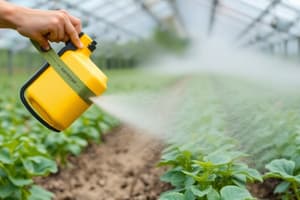Podcast
Questions and Answers
Which of the following is NOT a signal word indicating the level of hazard?
Which of the following is NOT a signal word indicating the level of hazard?
- Warning
- Health Hazard (correct)
- Danger-Poison
- Caution
Which of these symptoms would NOT be typically associated with pesticide exposure?
Which of these symptoms would NOT be typically associated with pesticide exposure?
- Dizziness
- Fever
- Pinpoint pupils
- Increased appetite (correct)
How does Personal Protective Equipment (PPE) primarily reduce the danger from pesticides?
How does Personal Protective Equipment (PPE) primarily reduce the danger from pesticides?
- By preventing dermal, inhalation, and eye exposure (correct)
- By diluting the pesticides
- By neutralizing the pesticides
- By changing the chemical composition of the pesticide
Besides wearing PPE, what other precaution should you take to reduce pesticide exposure?
Besides wearing PPE, what other precaution should you take to reduce pesticide exposure?
Who is specifically covered by the Hazard Communication Standard?
Who is specifically covered by the Hazard Communication Standard?
Which of the following is NOT a key feature of effective PPE?
Which of the following is NOT a key feature of effective PPE?
When wearing a spray suit for pesticide application, what additional eye protection is recommended?
When wearing a spray suit for pesticide application, what additional eye protection is recommended?
What type of respirator does NOT supply oxygen to the user?
What type of respirator does NOT supply oxygen to the user?
Which formulation is most likely to cause an issue if it encounters moisture?
Which formulation is most likely to cause an issue if it encounters moisture?
Which of the following is a primary disadvantage of using paste or gel pesticide formulations?
Which of the following is a primary disadvantage of using paste or gel pesticide formulations?
What is a significant disadvantage of using dust formulations in pest control?
What is a significant disadvantage of using dust formulations in pest control?
Which characteristic of ready-to-use spray formulations is considered an advantage?
Which characteristic of ready-to-use spray formulations is considered an advantage?
According to the provided text, what is a potential health risk related to using dust pesticides?
According to the provided text, what is a potential health risk related to using dust pesticides?
What is a key factor that can reduce the effectiveness of paste and gel pesticide formulations?
What is a key factor that can reduce the effectiveness of paste and gel pesticide formulations?
Which of these is a key advantage of using solid bait formulations?
Which of these is a key advantage of using solid bait formulations?
Which federal law regulates the production, transportation, sale, use, and disposal of pesticides?
Which federal law regulates the production, transportation, sale, use, and disposal of pesticides?
Which of the following best describes how halogens work to remediate mold?
Which of the following best describes how halogens work to remediate mold?
What is the primary purpose of inert ingredients in a pesticide formulation?
What is the primary purpose of inert ingredients in a pesticide formulation?
When selecting a pesticide formulation, which factor is LEAST important to consider?
When selecting a pesticide formulation, which factor is LEAST important to consider?
Which of the following is an advantage of using emulsifiable concentrates (EC)?
Which of the following is an advantage of using emulsifiable concentrates (EC)?
A significant disadvantage of using wettable powders (WP) is:
A significant disadvantage of using wettable powders (WP) is:
Which formulation type is known for having a lower exposure risk compared to others?
Which formulation type is known for having a lower exposure risk compared to others?
What characteristic of emulsifiable concentrates makes it easy to accidentally overdose?
What characteristic of emulsifiable concentrates makes it easy to accidentally overdose?
Which of the following is a potential hazard associated with using wettable powders (WP)?
Which of the following is a potential hazard associated with using wettable powders (WP)?
In what scenario should a victim NOT be kept flat on their back with legs elevated?
In what scenario should a victim NOT be kept flat on their back with legs elevated?
Which of the following is NOT a benefit of a proper pesticide storage area?
Which of the following is NOT a benefit of a proper pesticide storage area?
What should NEVER be stored in a pesticide storage facility?
What should NEVER be stored in a pesticide storage facility?
What feature is NOT recommended for a pesticide storage facility?
What feature is NOT recommended for a pesticide storage facility?
Before storing a pesticide, what should you ALWAYS ensure?
Before storing a pesticide, what should you ALWAYS ensure?
When arranging pesticides in storage, how should volatile pesticides be handled?
When arranging pesticides in storage, how should volatile pesticides be handled?
Which scenario would trigger compliance with the pesticide bulk storage rule (ATCP33)?
Which scenario would trigger compliance with the pesticide bulk storage rule (ATCP33)?
Why is mixing and loading pesticides considered a significant hazard?
Why is mixing and loading pesticides considered a significant hazard?
What is the minimum distance you should maintain from wells or surface water when mixing, loading, or cleaning pesticide application equipment?
What is the minimum distance you should maintain from wells or surface water when mixing, loading, or cleaning pesticide application equipment?
When is the use of a spill containment surface (mixing and loading pad) REQUIRED?
When is the use of a spill containment surface (mixing and loading pad) REQUIRED?
What is the recommended practice to maintain water supply safety when mixing and loading pesticides?
What is the recommended practice to maintain water supply safety when mixing and loading pesticides?
How should a pesticide container be rinsed to ensure proper cleaning?
How should a pesticide container be rinsed to ensure proper cleaning?
What is the primary concern when mixing two different pesticides together?
What is the primary concern when mixing two different pesticides together?
Under what condition does a pesticide become classified as waste?
Under what condition does a pesticide become classified as waste?
What is one way to minimize pesticide waste?
What is one way to minimize pesticide waste?
Which type of pesticide waste is typically suitable for disposal in a sanitary landfill?
Which type of pesticide waste is typically suitable for disposal in a sanitary landfill?
Why might landfill operators refuse to accept certain types of pesticide waste?
Why might landfill operators refuse to accept certain types of pesticide waste?
What is an appropriate method for solidifying leftover liquid pesticides?
What is an appropriate method for solidifying leftover liquid pesticides?
What is a primary action to take while managing a pesticide spill simultaneously?
What is a primary action to take while managing a pesticide spill simultaneously?
What type of assistance can state agencies provide during a pesticide spill event?
What type of assistance can state agencies provide during a pesticide spill event?
What is the main consequence of exceeding established tolerances for pesticide residues?
What is the main consequence of exceeding established tolerances for pesticide residues?
Why should direct applications to food or food handling surfaces be avoided?
Why should direct applications to food or food handling surfaces be avoided?
When applying pesticides, what is a key action you can take to protect people and pets?
When applying pesticides, what is a key action you can take to protect people and pets?
In the context of pesticide applications, when should you inform a customer?
In the context of pesticide applications, when should you inform a customer?
Why is posting of treated sites necessary after pesticide application?
Why is posting of treated sites necessary after pesticide application?
What is the purpose of a restricted-entry interval displayed on a pesticide application sign?
What is the purpose of a restricted-entry interval displayed on a pesticide application sign?
Flashcards
Halogens for Mold Remediation
Halogens for Mold Remediation
Chemical agents that kill microorganisms like mold by damaging their cell membranes.
Quaternary Ammonium (Quats)
Quaternary Ammonium (Quats)
Surface disinfectant, often used in cleaning products, that kills mold and bacteria.
Phenolics for Mold Remediation
Phenolics for Mold Remediation
A type of disinfectant used to treat equipment and surfaces, effective against mold and bacteria.
Pesticide Formulation
Pesticide Formulation
Signup and view all the flashcards
Inert Ingredients in Pesticides
Inert Ingredients in Pesticides
Signup and view all the flashcards
Emulsifiable Concentrations (EC)
Emulsifiable Concentrations (EC)
Signup and view all the flashcards
Wettable Powders (WP)
Wettable Powders (WP)
Signup and view all the flashcards
Flowables (F or AF)
Flowables (F or AF)
Signup and view all the flashcards
Danger-Poison, Danger, Warning, & Caution Labels
Danger-Poison, Danger, Warning, & Caution Labels
Signup and view all the flashcards
General Symptoms of Pesticide Exposure
General Symptoms of Pesticide Exposure
Signup and view all the flashcards
Personal Protective Equipment (PPE)
Personal Protective Equipment (PPE)
Signup and view all the flashcards
Precautions to Take to Reduce Pesticide Exposure
Precautions to Take to Reduce Pesticide Exposure
Signup and view all the flashcards
Hazard Communications Standard
Hazard Communications Standard
Signup and view all the flashcards
Features of Effective PPE
Features of Effective PPE
Signup and view all the flashcards
Proper Use of PPE
Proper Use of PPE
Signup and view all the flashcards
Types of Gloves for Pesticide Handling
Types of Gloves for Pesticide Handling
Signup and view all the flashcards
Liquid pesticide formulations
Liquid pesticide formulations
Signup and view all the flashcards
Ready-to-use sprays
Ready-to-use sprays
Signup and view all the flashcards
Poisonous baits
Poisonous baits
Signup and view all the flashcards
Dusts
Dusts
Signup and view all the flashcards
Solid baits
Solid baits
Signup and view all the flashcards
Main Federal Pesticide Law
Main Federal Pesticide Law
Signup and view all the flashcards
Agency overseeing pesticide registration
Agency overseeing pesticide registration
Signup and view all the flashcards
Pesticide Registration
Pesticide Registration
Signup and view all the flashcards
First Aid for Fainting
First Aid for Fainting
Signup and view all the flashcards
Pesticide Storage Facility
Pesticide Storage Facility
Signup and view all the flashcards
Pesticide Storage Conditions
Pesticide Storage Conditions
Signup and view all the flashcards
Air Gap
Air Gap
Signup and view all the flashcards
Pesticide Storage Precautions
Pesticide Storage Precautions
Signup and view all the flashcards
Pesticide incompatibility
Pesticide incompatibility
Signup and view all the flashcards
Arranging Pesticides in Storage
Arranging Pesticides in Storage
Signup and view all the flashcards
Triple Rinse
Triple Rinse
Signup and view all the flashcards
Short-Term Storage of Pesticides
Short-Term Storage of Pesticides
Signup and view all the flashcards
Pesticide Waste
Pesticide Waste
Signup and view all the flashcards
Hazardous Pesticide Waste
Hazardous Pesticide Waste
Signup and view all the flashcards
Bulk Pesticide Storage Rule
Bulk Pesticide Storage Rule
Signup and view all the flashcards
Proper Pesticide Waste Disposal
Proper Pesticide Waste Disposal
Signup and view all the flashcards
Mixing and Loading Pesticides
Mixing and Loading Pesticides
Signup and view all the flashcards
Licensed Hazardous Waste Management Facility
Licensed Hazardous Waste Management Facility
Signup and view all the flashcards
Mixing and Loading Restrictions
Mixing and Loading Restrictions
Signup and view all the flashcards
Spill Containment Surface
Spill Containment Surface
Signup and view all the flashcards
Solidifying Liquid Pesticide Waste
Solidifying Liquid Pesticide Waste
Signup and view all the flashcards
Pesticide Spill Containment
Pesticide Spill Containment
Signup and view all the flashcards
Pesticide Spill Cleanup
Pesticide Spill Cleanup
Signup and view all the flashcards
State Assistance for Pesticide Spills
State Assistance for Pesticide Spills
Signup and view all the flashcards
Pesticide Tolerance Levels
Pesticide Tolerance Levels
Signup and view all the flashcards
Preventing Excessive Pesticide Residues
Preventing Excessive Pesticide Residues
Signup and view all the flashcards
Concerns with Pesticide Use near Food
Concerns with Pesticide Use near Food
Signup and view all the flashcards
Protecting People and Pets from Pesticides
Protecting People and Pets from Pesticides
Signup and view all the flashcards
Notice Requirements for Pesticide Applications
Notice Requirements for Pesticide Applications
Signup and view all the flashcards
Study Notes
Mold Remediation Products
- Halogens are oxidizing agents that kill microorganisms by damaging their cell membranes
- Quaternary ammonium compounds (quats) are used on surfaces
- Phenolics are used to treat equipment and surfaces
Formulation Definition
- A formulation is a mixture of active and inert ingredients
- Inert ingredients don't have pesticide activity but improve application, safety, and handling.
Different Formulations
- Pesticides are more effective in certain formulations
- Consider intended use, application equipment, target reach, potential surface damage, and alternative less hazardous options.
Emulsifiable Concentrates (EC)
- Advantages: easy to handle, transport, store, measure, and require little agitation; leave little visible residue
- Disadvantages: high concentration, potential for overdose or mixing/calibration errors; may damage surfaces, easily absorbed through skin, splashes and spills are difficult to clean, may have a strong odor and be corrosive to application equipment, flammable
Wettable Powders (WP)
- Advantages: easy to store, transport, and handle; less likely to harm treated plants, animals, and surfaces; not phytotoxic; less risk of skin/eye absorption
- Disadvantages: must be weighed, difficult to mix; requires good and constant agitation in the spray tank; abrasive to pumps and nozzles
Flowables
- Advantages: low exposure risk, not phytotoxic, seldom clog nozzles; splashes are less likely compared to other liquid formulations
- Disadvantages: need shaking before measuring and mixing; containers may be difficult to rinse; require moderate agitation; may leave a visible residue
Ready-to-Use or Pre-mixed Sprays
- Advantages: neither measuring nor mixing is required; some are packaged with application devices; less personal exposure risk
- Disadvantages: limited availability, high cost per unit of active ingredient
Pastes, Gels, and Injectable Baits
- Advantages: odorless; low toxicity to humans; long-lasting; low exposure risk; effective at minimizing human and pet exposure; highly accurate placement and dosage
- Disadvantages: becomes contaminated when exposed to other pesticides or cleaning products; may run and drip at high temperatures; may stain porous surfaces; repeated applications can cause unsightly buildup
Dusts
- Advantages: usually ready-to-use; good alternative where moisture may damage application; simple application equipment
- Disadvantages: easily drifts off target; may irritate eyes, nose, throat and skin; risk of inhalation exposure; dampness can cause clumping; uneven distribution of particles
Solid Baits
- Advantages: ready-to-use; entire area doesn't require coverage; controls pests that move in and out of an area
- Disadvantages: may be attractive to children and pets; may kill domestic animals or non-target wildlife; requires careful placement; pest may prefer other food to the bait; undesirable odor from dead vertebrate pests
Other Information
- Federal Insecticide, Fungicide, and Rodenticide Act (FIFRA) is the prominent US federal pesticide law
- EPA registers pesticide products for sale and use
- Some products are classified "restricted-use" to be used only by trained personnel
- State laws can be stricter than federal laws, but cannot be less stringent
- Commercial and private applicators have specific use roles and responsibilities
Studying That Suits You
Use AI to generate personalized quizzes and flashcards to suit your learning preferences.




